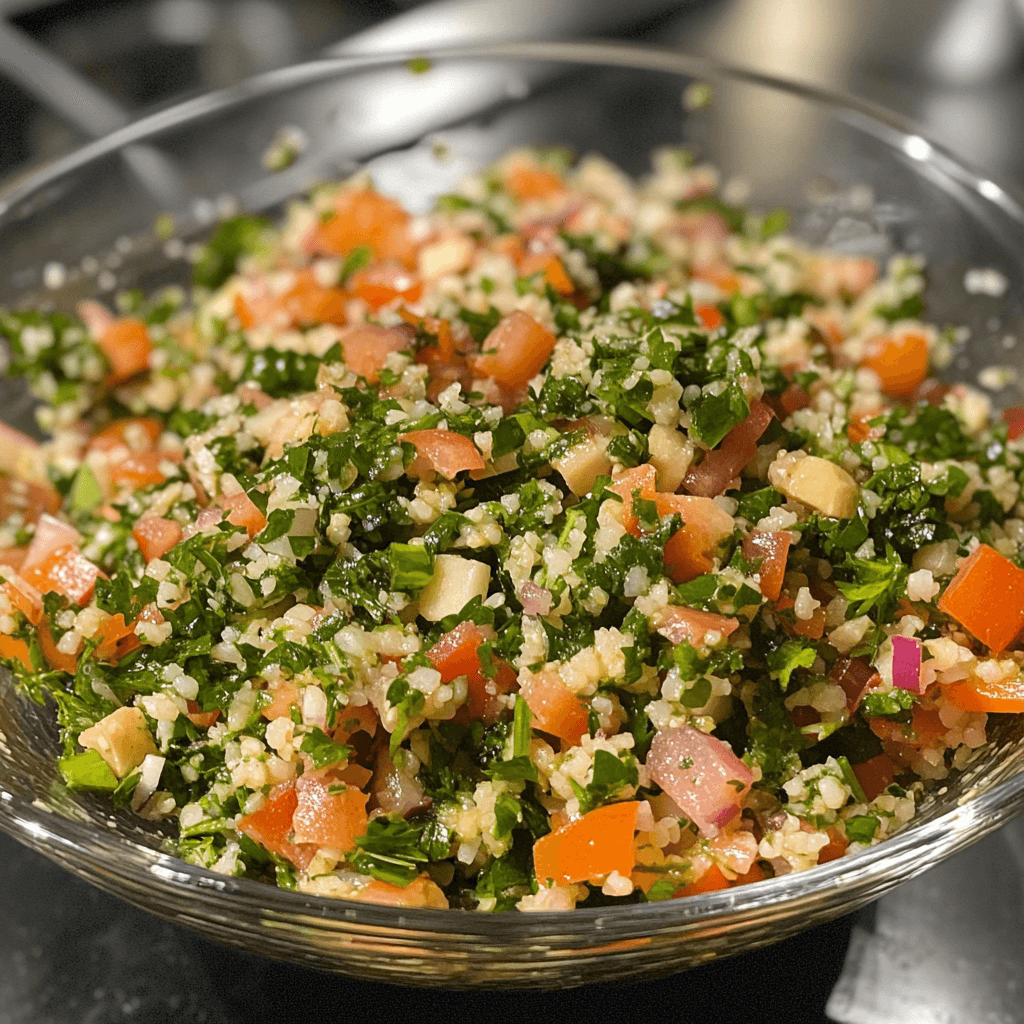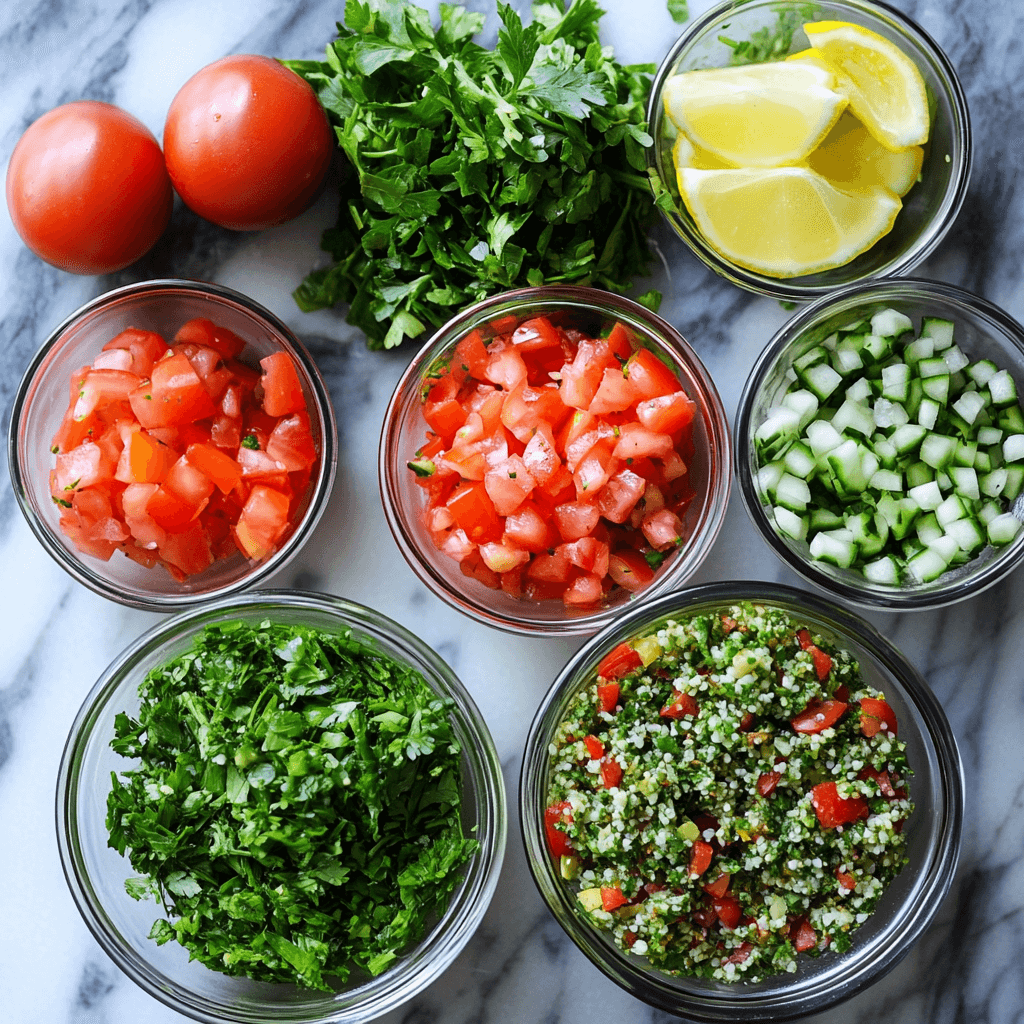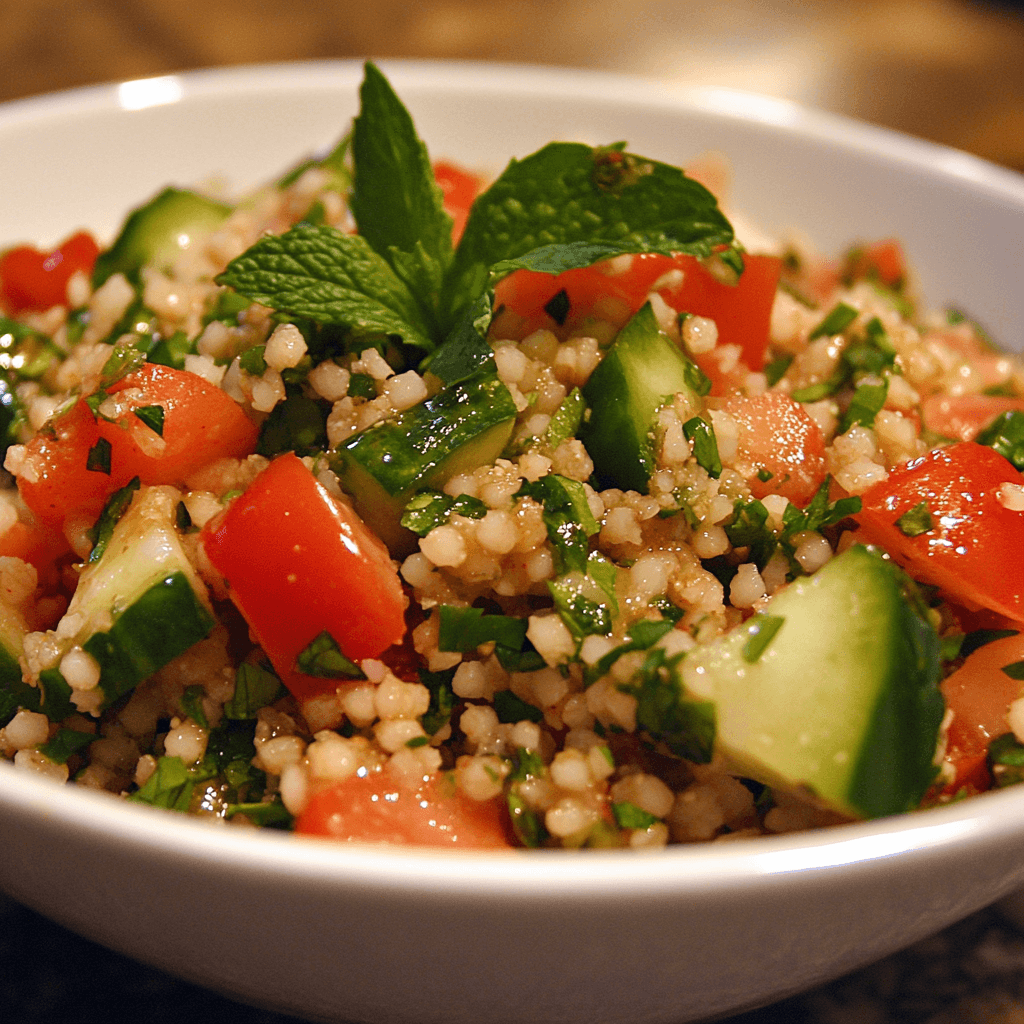Tabbouleh salad, with its vibrant colors and refreshing flavors, is a beloved dish that originated in the Middle East. Known for its fresh parsley, tomatoes, and bulgur wheat base, this aromatic salad has become a popular choice for those seeking a light, healthy, and flavorful meal. Whether you’re enjoying it on a warm summer day or pairing it with grilled meats and falafel, tabbouleh is versatile, refreshing, and nutritious. In this article, we will explore everything there is to know about tabbouleh salad—from its history and ingredients to serving suggestions and health benefits. Let’s dive into this classic Middle Eastern dish!
Overview of the Recipe
Tabbouleh is a Mediterranean salad traditionally made with bulgur wheat, parsley, tomatoes, cucumbers, onions, and mint. It is dressed with olive oil, lemon juice, and sometimes a touch of salt and pepper. The high proportion of fresh herbs is what gives tabbouleh its distinct flavor, with parsley acting as the main ingredient. Unlike most salads that rely on greens like lettuce or spinach, tabbouleh showcases the vibrant flavors of vegetables, grains, and fresh herbs.
The key to making a great tabbouleh lies in using high-quality ingredients, ensuring the balance of flavors between the tangy lemon, the earthiness of bulgur, and the herbaceous freshness of parsley and mint. It’s typically served as part of a mezze platter, a Middle Eastern spread of small dishes, but it can also be enjoyed as a light lunch, side dish, or even as a filling for wraps.

History and Origin
Tabbouleh has deep roots in the Middle East, particularly in Lebanon, Syria, and Palestine. It is considered a traditional dish in these countries and is often featured at family gatherings, festivals, and special occasions. The name “tabbouleh” comes from the Arabic word “tabbūla”, meaning “seasoned,” a nod to the abundant use of fresh herbs and seasonings in the salad.
Historically, tabbouleh was made primarily with bulgur wheat, parsley, and tomatoes. It’s believed that the dish originated in the mountainous regions of Lebanon and Syria, where the availability of fresh herbs like parsley was abundant. Over time, tabbouleh spread to other parts of the Arab world and became a staple of Mediterranean cuisine.
While tabbouleh’s core ingredients have remained largely the same, the dish has evolved, and many variations can now be found, depending on regional preferences and available ingredients. In modern-day cooking, some variations of tabbouleh may include quinoa, couscous, or rice in place of bulgur, and other ingredients such as avocado or feta cheese can be added for extra flavor.
Ingredients
Traditional tabbouleh salad consists of a few simple ingredients that work together to create a balanced and flavorful dish. Below are the essential ingredients to make an authentic tabbouleh salad:
Salad:
- 1 cup bulgur wheat (fine or medium, depending on your texture preference)
- 2-3 cups fresh parsley, finely chopped (parsley should be the primary ingredient)
- 1 cup fresh mint leaves, finely chopped
- 3-4 medium tomatoes, diced
- 1 medium cucumber, diced (optional)
- 1 small red onion, finely diced
- 1/4 cup olive oil
- Juice of 2-3 lemons
- Salt and pepper, to taste
Dressing:
- 3 tbsp olive oil
- 1 tbsp lemon juice
- 1 clove garlic, minced (optional)
- 1/2 tsp ground cumin (optional)
- Salt and pepper, to taste
Note: Depending on personal preferences or regional variations, some people may add a handful of chopped green onions or radishes, or include additional herbs like dill or basil.

Instructions
1: Prepare the Bulgur Wheat
- Start by rinsing the bulgur wheat under cold water to remove any dust or impurities.
- In a large bowl, combine the bulgur with 1 1/4 cups hot water. Cover the bowl with a lid or plastic wrap and let the bulgur steam for about 15 minutes, or until it softens and absorbs all the water.
- Once the bulgur is tender, fluff it with a fork to separate the grains and allow it to cool completely.
2: Prepare the Vegetables and Herbs
- While the bulgur is cooling, finely chop the fresh parsley and mint leaves. Use a sharp knife to ensure the herbs are finely minced for a nice texture.
- Dice the tomatoes, cucumber (if using), and red onion. Be sure to remove any excess moisture from the tomatoes and cucumber by gently pressing them between paper towels. This helps prevent the salad from becoming too watery.
3: Make the Dressing
- In a small bowl, whisk together the olive oil, lemon juice, garlic (if using), and cumin (if using).
- Add a pinch of salt and pepper to taste. You can adjust the lemon and seasoning to your liking, but the dressing should be tangy and slightly salty to balance the fresh herbs.
4: Assemble the Salad
- In a large mixing bowl, combine the cooled bulgur wheat with the chopped parsley, mint, tomatoes, cucumber, and onion.
- Pour the dressing over the salad and toss gently to combine all the ingredients. Be sure the dressing is evenly distributed throughout the salad.
- Taste and adjust the seasoning as needed, adding more salt, pepper, or lemon juice if desired.
5: Let It Rest
Allow the tabbouleh to sit for about 30 minutes in the refrigerator before serving. This resting time helps the flavors meld together and gives the herbs time to absorb the dressing.
6: Serve and Enjoy
Once the tabbouleh has rested, serve it chilled or at room temperature. Garnish with additional fresh mint leaves or a drizzle of olive oil if desired.
Pairing and Serving Suggestions
Tabbouleh is an incredibly versatile dish and can be served in many ways. Here are a few pairing and serving suggestions to enhance your meal:
As a Side Dish:
- Grilled Chicken or Lamb: Tabbouleh pairs wonderfully with grilled meats, especially chicken or lamb, as the freshness of the salad contrasts nicely with the savory flavors of the meat.
- Falafel: Tabbouleh is often served as part of a mezze platter, which includes falafel, hummus, baba ganoush, and pita bread. It complements the rich, crispy falafel perfectly.
- Shawarma: Tabbouleh also works well alongside shawarma wraps or plates, adding a light, zesty contrast to the spicy flavors of the meat.
As a Main Course:
- Wrap it up: Tabbouleh can be used as a filling for pita or flatbreads, along with hummus or grilled veggies, making for a healthy and satisfying wrap.
- Grilled Halloumi: For a vegetarian main course, serve tabbouleh with slices of grilled halloumi cheese for a delightful combination of textures.
With Other Salads:
- Greek Salad: Tabbouleh pairs beautifully with Greek salad, especially when served with olives, feta cheese, and a simple vinaigrette.
- Roasted Vegetable Salad: Tabbouleh adds a refreshing contrast to a warm roasted vegetable salad, such as one with sweet potatoes, eggplant, and bell peppers.
Variations of the Recipe
While the traditional version of tabbouleh is made with bulgur wheat, there are plenty of ways to modify the recipe to suit your dietary preferences or to use ingredients you have on hand. Here are a few variations to consider:
1. Quinoa Tabbouleh
For a gluten-free option, swap the bulgur wheat with quinoa. Quinoa is a protein-packed, gluten-free grain that offers a similar texture to bulgur but is perfect for those avoiding gluten.
2. Cauliflower Rice Tabbouleh
For a low-carb version, you can substitute bulgur wheat with cauliflower rice. Simply pulse cauliflower florets in a food processor until they resemble rice grains, then steam or sauté lightly before adding it to the salad.
3. Avocado Tabbouleh
For added creaminess, consider adding avocado to your tabbouleh. Dice the avocado and gently toss it in at the end to avoid mashing it.
4. Add More Vegetables
Feel free to add other vegetables to your tabbouleh for extra crunch and flavor. Radishes, bell peppers, or even carrots can make a great addition to the traditional recipe.
5. Vegan Tabbouleh with Feta
Although traditional tabbouleh doesn’t contain feta cheese, you can add vegan feta or traditional feta for a creamy, tangy element that balances the salad’s freshness.
Health Benefits Notes
Tabbouleh is a nutritious, low-calorie, and fiber-rich dish that offers many health benefits. Some of the key health advantages of eating tabbouleh include:
- High in Fiber: Bulgur wheat (or quinoa) is a great source of fiber, which aids digestion, helps regulate blood sugar, and promotes satiety.
- Packed with Antioxidants: Fresh herbs like parsley and mint, as well as tomatoes and cucumbers, are loaded with antioxidants that help combat inflammation and support overall health.
- Rich in Vitamins and Minerals: Parsley is high in vitamins A, C, and K, and cucumbers are a hydrating, low-calorie vegetable rich in water content. The lemon juice adds vitamin C, which supports the immune system.
- Heart-Healthy: The olive oil in the dressing is a good source of monounsaturated fats, which are beneficial for heart health.
FAQs
Can I make tabbouleh ahead of time?
Yes! Tabbouleh actually tastes better after it has had time to sit, as the flavors meld together. You can prepare it a day ahead and store it in the fridge for up to 2-3 days.
Can I use couscous instead of bulgur?
Yes, couscous is a great alternative to bulgur, although it has a slightly different texture. You can use either one, depending on your preference.
Is tabbouleh gluten-free?
Traditional tabbouleh made with bulgur wheat is not gluten-free. However, you can make a gluten-free version by using quinoa or cauliflower rice instead.
Conclusion
Tabbouleh is a delightful and nutritious dish that captures the essence of Middle Eastern cuisine with its fresh ingredients, bold flavors, and health benefits. Whether you’re looking for a light meal, a side dish, or something to share at a gathering, tabbouleh offers versatility and satisfaction in every bite. With its combination of wholesome grains, fresh vegetables, and herbs, it’s no wonder this iconic salad has remained a favorite for generations.
Recommended (Some Other Recipes)
- Hummus: A classic dip made with chickpeas, tahini, olive oil, and lemon—perfect alongside tabbouleh.
- Falafel: Crispy, golden-brown falafel made from ground chickpeas and herbs, often served with tabbouleh.
- Grilled Chicken Shawarma: Marinated chicken grilled to perfection, typically served with tabbouleh and a garlic yogurt sauce.
- Baba Ganoush: A smoky eggplant dip that pairs wonderfully with tabbouleh on a mezze platter.
- Fattoush Salad: Another Middle Eastern salad, made with crispy pita, fresh vegetables, and a tangy dressing—an excellent pairing with tabbouleh.

